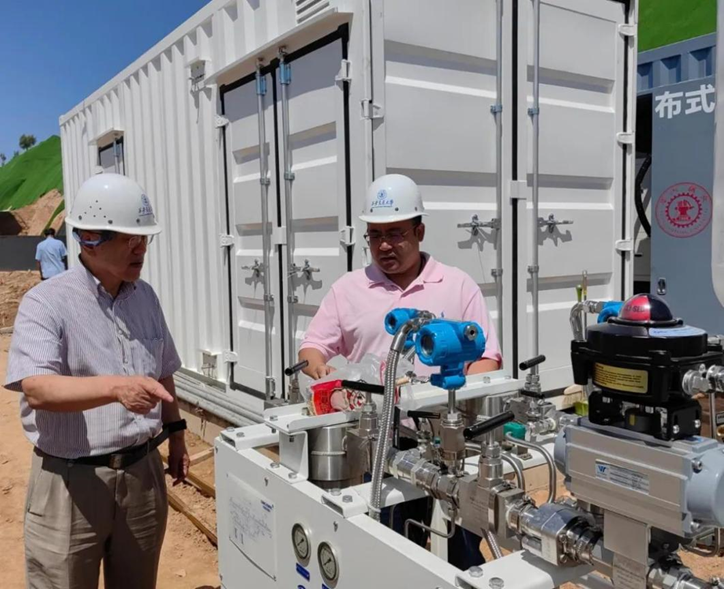Yulin Sci-Tech Innovation City announced the successful completion of a demonstration project for the world's first zero-carbon smart energy center. This project marks the world's first practical and at-scale application of a hydrogen-integrated zero-carbon multi-source energy supply system, offering a new technical pathway through which China may achieve its carbon peaking and carbon neutrality goals.
A team of experts from China Unicom Shaanxi and Xi'an Jiaotong University provided essential technical support for this project. The project consists of an energy station, hydrogen production and storage systems, hydrogen fuel cell systems, PV power systems, heated and chilled water storage systems, and shallow geothermal wells. These systems are operated and monitored in real time through a 5G digital twin system to enable intelligent collaboration among sensing, communication, computing, and optimization capabilities.
The project harnesses solar energy through PV panels to produce clean electricity. Any surplus electricity is used to electrolyze water to generate hydrogen. This hydrogen, along with that generated by Yulin's hydrogen energy supply chain, is then converted into electricity and thermal energy through the hydrogen fuel cell systems. Thermal energy can be converted into cold energy through heat pumps and stored in the heated (chilled) water storage systems. The electricity, thermal energy, and cold energy are supplied to the buildings, 5G base stations, and 5G data centers that cover an indoor area of more than 4000 square meters. Moreover, the project makes use of Yulin's shallow geothermal wells to store waste heat.
To provide quality 5G coverage for the energy center, the project team pioneered the combination of 5G and passive metasurfaces to control the transmission directions of 5G signals. This approach not only addressed the signal attenuation and instability issues caused by the center's large metal storage tanks, it also serves as a practical experiment with materials that will be vital for the application of 6G technology. In addition, the project also marked the world's first use of 5G + deterministic time network technology for centralized power control and frequency regulation, which enhanced the model precision, operational reliability, and supply stability of the power system.
"Our project team combined 5G with the zero-carbon energy system to enable a latency difference and clock synchronization precision of within 10 μs for centralized control and frequency regulation of the electric power system. The metasurfaces we've employed here give us over 10 dB of gain, which allows thousands of 5G terminals to connect seamlessly without any blind spots. This really helps keep the zero-carbon smart energy system running safely," said Li Shouqing, 5G technical director of the project.

Academician Guan Xiaohong (left) and Professor Xu Zhanbo inspecting the zero-carbon energy center
The project is expected to reduce the energy supply cost to approximately CNY0.36/kWh over its design service life, compared to more than CNY0.57/kWh for traditional power grids and municipal heat supply. This enables the project to achieve more than 60% savings on its annual operating costs, leading to a total cost reduction of 36%. Furthermore, the project achieves 100% utilization of renewable energy and boasts a comprehensive energy utilization rate exceeding90%. As a result, it decreases annual carbon dioxide emissions by over 8,640 tons, equivalent to planting 480,000 trees. "We can expect to recoup the extra initial investment for the project in just three to four years, which really shows how economical it is to protect the environment," said Xu Zhanbo, executive director of the project and professor at Xi'an Jiaotong University.
Project leader Guan Xiaohong, who is also an Academician of the Chinese Academy of Sciences and Professor at Xi'an Jiaotong University, led the team in addressing six key technologies, including the modeling, intelligent design, and collaborative optimization for the hydrogen-integrated multi-source energy supply system. The team carried out R&D and verification in the Western China Science and Technology Innovation Harbor, and successfully completed the first application and achievement transformation in Yulin. They have applied for a total of 33 patents, 16 of which have already been granted.

Academician Guan Xiaohong explaining key technologies in the lab
The project has successfully provided a zero-carbon energy supply for the athletes' village of the 17th Shaanxi Provincial Games, covering an area of 120,000 square meters. Based on public information, this project is the world's first practical, at-scale zero-carbon smart energy center, paving the way for the development of green, secure, and efficient energy systems.

